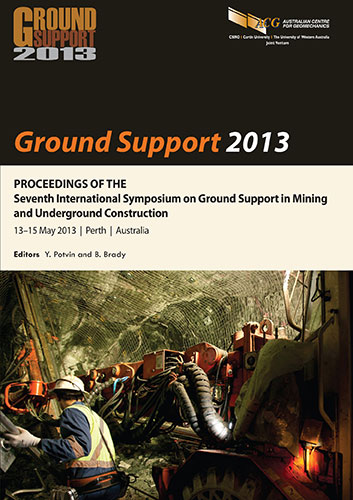Emerging technologies in corrosion protection and acid resistance for ground support elements

|
Authors: Evans, DW Paper is not available for download Contact Us |
DOI https://doi.org/10.36487/ACG_rep/1304_33_Evans
Cite As:
Evans, DW 2013, 'Emerging technologies in corrosion protection and acid resistance for ground support elements', in Y Potvin & B Brady (eds), Ground Support 2013: Proceedings of the Seventh International Symposium on Ground Support in Mining and Underground Construction, Australian Centre for Geomechanics, Perth, pp. 485-496, https://doi.org/10.36487/ACG_rep/1304_33_Evans
Abstract:
Corrosion in ground support elements remains an important area for industry focus, given the immediate concern for mine safety and operational efficiencies, as well as the hidden cost of longer term rehabilitation work. This paper discusses emerging technologies within the fields of corrosion protection and acid resistance that are providing new solutions for specific application areas within a number of ground support product designs. Traditionally, anti-corrosion strategies have predominantly focussed upon Hot Dip Galvanising as a common industry solution. However, now complimenting this traditional solution, the more recent technology of Thermal Diffusion Galvanising is gaining interest within the Australian market, providing commercially viable solutions for a number of specific application areas that Hot Dip Galvanising cannot address. Thermal Diffusion Galvanising is an alternate zinc based technology, which offers equivalent cathodic protection to that of Hot Dip Galvanising. Thermal Diffusion Galvanising has a comparatively deeper metallurgical bond to the steel substrate through various zinc-iron alloy layers, offering both increased adhesion and greater surface hardness. Beyond the capabilities of Hot Dip Galvanising, Thermal Diffusion Galvanising has specific applications of interest in high tensile steel grades, coating thickness consistency for threadforms, excellent torque/tension performance and greater flexibility with deformation. Thermal Diffusion Galvanising also continues to provide spark reduction properties on friction contact. Processing advantages also exist, with reduced concern for entrapped air pockets within the product design. Research suggests that the greater percentage of iron alloy content within Thermal Diffusion Galvanising may offer a greater threshold for resistance to moderate pH environments. However, for low pH environments, zinc based coatings will rapidly degrade and do not provide any lasting protective benefit. Subsequently, neither Hot Dip Galvanising nor Thermal Diffusion Galvanising are suited to low pH conditions. Rather, barrier protection must be provided for ground support applications, either as a direct surface coating, or as a sheathing. Using the range of available technologies, product applications are under development that offer a suite of solutions – Thermal Diffusion Galvanising, acid resistant coatings and sheathing barriers. This paper provides a technical summary of the detailed attributes of Thermal Diffusion Galvanising and its relative performance compared to that of Hot Dip Galvanising. The paper also details specific technologies for acid resistant barrier coatings. Applications of these technologies to ground support elements are then reviewed, relating this field of technology to specific product design areas and field applications.
References:
Alvey, C.E. (2002) Evaluation of Distek Thermodiffusion Coating, Corrosion Advisory Technical Services, 18th December.
ArmorGalv (2012) Testing of Armorgalv protected tie downs on active LCAC starting July.12.2010, viewed 20 January 2013, .
ASTM (2008) Standard Specification for Zinc Alloy Thermo-Diffusion Coatings (TDC) on Steel Fasteners, Hardware and Other Products A1059/A 1059M – 08, 15th November.
Bodycote (2006) Hinge pins for roof support systems in mining applications, viewed 20 January 2013, .
British Standards Institution (2003) Sherardizing – Zinc diffusion coatings on ferrous products – Specification BS EN 13811:2003, 13th May.
British Standards Institution (1990) PD6484: 1979 Commentary on Corrosion at Bimetallic Contacts and Its Alleviation.
Department of the Navy (2011) Authorization to Utilize Thermo-Diffusion Zinc Process as Alternative to Electrodeposited and Hot-Dip Zinc Coatings, Naval Sea Systems Command, 2nd August.
Engineers Handbook (2006) Manufacturing Processes – Powder Coating – Surface Finishing, viewed 20 January 2013,
Fahey, A. (2013) Copper accelerated acetic acid salt spray, Bureau Veritas, 30th January.
Fullston, D., Ganther, W.D. and Thomson, G. (2004) Zinc coating thickness effects on hot dip galvanized steel corrosion rates at a severe marine site, Corrosion and Materials, Vol. 29, 1, pp. 5–8.
Jeffrey, R. (2010) Evaluation of Corrosion Resistance of Mining Products, Pacific Testing, 4th November.
Kainuma, R. and Ishida, K. (2007) Reactive Diffusion between Solid Fe and Liquid Zn at 723K, ISIJ International, Vol. 47, 5, pp. 740744.
Potvin, Y., Nedin, P., Sandy, M., Rosengren, K. and Rosengren, M.D. (2001) Towards the Elimination of Rockfall Fatalities in Australian Mines, MERIWA report No. 223, Project No. M341, Government of Western Australia, ACG:1009-01, 54 p.
RMS (2012a) QA Specification B240 Supply of Bolts, Nuts, Screws and Washers, June 25.
RMS (2012b) QA Specification R64 Soil Nails, November 21.
Swain, K. (2010) TDG Coating Hardness and Micrograph, Austpower Engineering, 21st December.
Villaescusa, E., Hassell, R. and Thompson, A. (2007) Corrosion of Rock Reinforcement in Underground Excavations, Western Australia School of Mines, Kalgoorlie, pp. 1–3.
© Copyright 2024, Australian Centre for Geomechanics (ACG), The University of Western Australia. All rights reserved.
View copyright/legal information
Please direct any queries or error reports to repository-acg@uwa.edu.au
View copyright/legal information
Please direct any queries or error reports to repository-acg@uwa.edu.au